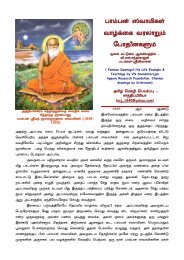02 - PRK Skanda - Murugan Bhakti
02 - PRK Skanda - Murugan Bhakti
02 - PRK Skanda - Murugan Bhakti
Create successful ePaper yourself
Turn your PDF publications into a flip-book with our unique Google optimized e-Paper software.
<strong>Skanda</strong>, the Merciful,<br />
and His devotees<br />
P. R. Kannan<br />
In the <strong>Skanda</strong> Puranam<br />
Mercy is the greatest attribute of Lord <strong>Skanda</strong>,<br />
which brings him closest to his devotees. Upanishad<br />
says that compassion and charity was<br />
advised by Prajapati the most essential quality to<br />
be cultivated by humans. <strong>Skanda</strong>’s birth itself<br />
was out of the mercy of Siva and Devi towards<br />
Devas who were tortured by Surapadma and his<br />
brother Asuras. As one of his Balalilas, <strong>Skanda</strong><br />
killed all Devas during an encounter; he brought<br />
them back to life at the prayer of Brihaspati; thus<br />
he eliminated the ego of power of the Devas. The<br />
Tamil Kandapuranam refers to the six faces of<br />
<strong>Skanda</strong> as all representing compassion. When<br />
he was a kid, a Brahmin, who was performing a<br />
yagna, encountered a gigantic goat which suddenly<br />
emerged out of the sacrificial animal and<br />
violently attacked the whole world. <strong>Skanda</strong><br />
brought the offending goat under control and<br />
made it his first vehicle. He taught a lesson to a<br />
haughty Brahma and jailed him. <strong>Skanda</strong> was<br />
unique in his accomplishments; he preached<br />
Pranava to Siva and later to sage Agastya.<br />
During the first great war, when Krauncha<br />
‘devoured’ Veerabahu and the army of <strong>Skanda</strong><br />
inside his mountain, it was <strong>Skanda</strong> who used his<br />
Vel (spear) to destroy the mountain and bring<br />
out the army safe and sound. He then sent his<br />
brother Veerabahu as emissary of peace to Soorapadma.<br />
Veerabahu was not offered a seat in the<br />
royal assembly of Soorapadma. <strong>Skanda</strong> materialized<br />
a beautiful royal throne for Veerabahu.<br />
<strong>Skanda</strong> also appeared in the dreams of Jayanta<br />
and other Devas who were in Soorapadma’s<br />
prison and assured them of good times ahead.<br />
During the subsequent war with Soorapadma,<br />
<strong>Skanda</strong> protected Veerabahu at least on three<br />
critical occasions. Once Veerabhahu was immobilized<br />
by Bhanukopa using Mohanastram; <strong>Skanda</strong><br />
countered by employing Amoghastram. The<br />
second time Veerabahu was thrown far into the<br />
sea by the use of Sammohanastram; <strong>Skanda</strong><br />
sent his Vel (spear) to bring him back. The third<br />
time Simhamukha bound Veerabahu with the<br />
chain of Maya and threw him into the Udayagiri;<br />
<strong>Skanda</strong> again rescued Veerabahu using his deft<br />
arrows. When Veerabahu killed Bhanukopa after<br />
a protracted battle, <strong>Skanda</strong> gave him a boon.<br />
Veerabahu did not opt for the position of Brahma<br />
or Indra; but prayed for unwavering bhakti at the<br />
lotus feet of <strong>Skanda</strong>. <strong>Skanda</strong> blessed accordingly<br />
saying that the devotion he granted him was<br />
never bestowed even upon Devas, whose commander<br />
<strong>Skanda</strong> was.<br />
When Soorapadma stood alone on the battlefield<br />
on the second day, having lost all his weapons<br />
including chariot, <strong>Skanda</strong> gracefully permitted<br />
him to leave, rest and return fully armed the<br />
next day. This is reminiscent of what Rama did<br />
to Ravana as conveyed in Valmiki Ramayanam.<br />
In the last day of the war, <strong>Skanda</strong> showed Visvarupa<br />
to Soorapadma on the battlefield; Surapadma<br />
temporarily recognized the divinity of the<br />
little boy who was waging the terrible war. He<br />
appeared in the form of a gigantic mango tree,<br />
which was dissected into two parts by the Vel<br />
(spear) of <strong>Skanda</strong>. The peacock and cock, which<br />
emerged now, were very aggressive and rushed<br />
m OCT / DEC 2009 K 1
towards <strong>Skanda</strong>. <strong>Skanda</strong> quietened them gracefully<br />
and blessed them with Vignana, the highest<br />
Advaitic spiritual experience. The fearful Asura<br />
thus turned into the divine vehicle and flag,<br />
worthy of devotees’ reverence.<br />
<strong>Skanda</strong> then answered the long standing<br />
prayer of Devasena and Valli by marrying them.<br />
During the courtship with Valli there was an<br />
occasion when Valli’s own father and other kith<br />
and kin who opposed the marriage initially were<br />
all killed by the mere sound raised by the cock on<br />
<strong>Skanda</strong>’s flag. <strong>Skanda</strong> very compassionately<br />
brought all of them back to life.<br />
<strong>Skanda</strong> himself declares in <strong>Skanda</strong> Puranam:<br />
If someone treats me badly, I shall tolerate it. But<br />
those who trouble devotees of my lotus feet,<br />
whether they be Devas, Danavas or others, are<br />
sure to meet their punishment at my hands” Such<br />
is the mercy of <strong>Skanda</strong>.<br />
In Modern Times<br />
It is believed that during the time of Adi Sankaracharya,<br />
one Abhinavagupta wrought upon<br />
the master some severe illness through ‘Aabhichara<br />
Prayoga’. Adi Sankara got himself completely<br />
cured at Tiruchendur, where he composed<br />
the famous ‘Subramanya Bhujangam’.<br />
The vibhuti given on ‘Panneer leaf’ at the temple<br />
is considered efficacious in curing the severest<br />
of physical and mental illnesses. Kachchiappa<br />
Sivacharya wrote the classical Kanda Puranam<br />
in Tamil after <strong>Skanda</strong> appeared before him and<br />
blessed him with the initial words.<br />
Saint Arunagirinathar of the fifteenth century<br />
is the most towering name among <strong>Skanda</strong> bhaktas.<br />
In his younger days, he repented for his evil<br />
ways and attempted suicide by falling from the<br />
Vallala tower of the Arunachalesvara temple at<br />
Tiruvannamalai. <strong>Skanda</strong>, mounted on his peacock,<br />
appeared and rescued him during the fatal<br />
drop. The merciful lord guided him to sing<br />
his praises starting with the word ‘Muthu’. The<br />
soulful compositions of the saint are many -<br />
Tiruppugazh, Kandar Anubhuti, Kandar. Alankaram,<br />
Kandar Andadi etc. These songs have<br />
stood the test of time and are very popular even<br />
today in spite of the tough classical Tamil in<br />
which they are couched. At Tiruchendur Arunagirinathar<br />
had the darshan of dancing Nataraja in<br />
the idol of Subramania. Tiruchendur is also believed<br />
to be the place where he defeated a poet<br />
Villiputhuran by compossing some difficult<br />
songs in praise of <strong>Skanda</strong>. The saint reformed<br />
the arrogant poet.<br />
Kumara Guruparar, who was born dumb, was<br />
brought by his parents to the Tiruchendur temple<br />
at the age of five. They observed austerities for<br />
48 days. At the end of this period, <strong>Skanda</strong><br />
appeared in the night in the dream of the child<br />
and wrote on his tongue the Shadakshari mantra.<br />
The child immediately broke into the devotional<br />
song ‘Kandar Kalivenba’. He was then<br />
blessed by Goddess Meenakshi at Madurai,<br />
who appeared as young girl. Saraswati blessed<br />
2 K OCT / DEC 2009 m
him with mastery of Hindi language. Mounted<br />
on a lion, he faced the Sultan at Kashi. He established<br />
a mutt at Kashi at Kedarghat.<br />
Another great devotee, Devaraya Swamigal,<br />
composed the ever-popular Kandar Shashti<br />
Kavacham at Tiruchendur. Like some of the<br />
Tiruppugazh songs, this Kavacham has some<br />
mystic syllables of deep significance. Kumara<br />
Gurudasa Swamigal, popularly known as<br />
Pamban Swamigal, is the author of ‘Shanmukha<br />
Kavacham’ and ‘Kumara Sthavam’.<br />
In 1923 he met with an accident while walking<br />
on the road at Chennai. The wheel of a horsecart<br />
ran over his leg. He was hospitalized and<br />
the British doctors who treated his gave up all<br />
hopes for his recovery. But the saint was confident<br />
and said: “After singing Shanmukha<br />
Kavacham, if I am not cured, people will lose<br />
faith”. On the eleventh day, he saw two peacocks<br />
dancing their way towards him. Lord<br />
Subramania himself lay beside him as a child.<br />
Needless to say he was instantly rid of all his<br />
illness.<br />
Ramana Maharshi was hailed as an Avatara<br />
of <strong>Skanda</strong> by his distinguished disciple,<br />
Kavyakanta Ganapathi Muni. In his famous<br />
‘Ramana Gita’. Ganapathi Muni asserts in his<br />
address to the Maharshi: Oh Brahman, through<br />
God given vision, I behold you again and again<br />
as Subramanya, the best of Brahmanyas, in<br />
human form” (11:7). Muthuswami Dikshitar,<br />
the great Carnatic music composer was blessed<br />
by <strong>Skanda</strong> at Tiruttani. Appearing as an old man,<br />
the Lord dropped a piece of candy in the month<br />
of Dikshitar on the steps of the temple. Dikshitar,<br />
who instantly became composer of soul-stirring<br />
songs on Devi, <strong>Skanda</strong> and other divinities. He<br />
used ‘Guru Guha’ as his signature in all his<br />
compositions.<br />
The great Tamil scholar, Ki Va Jagannathan<br />
was a great devotee of Tiruppugazh. He quoted<br />
Seshadri Swamigal as saying that Tiruppugazh<br />
is Mahamantra, each letter of which has been<br />
approved by <strong>Skanda</strong>. When his mother’s life was<br />
ebbing, Ki. Va. Ja sat at her head and recited<br />
Tiruppugazh continuously. His relatives had to<br />
intervene and say to him: “Yama is afraid of<br />
coming near her as you are reciting Tiruppugazh.<br />
Stop the recitation and prostrate to your mother.”<br />
Immediately the soul left the body.<br />
Vallimalai Sachchidananda Swamigal spent<br />
his lifetime at Vallimalai worshipping <strong>Skanda</strong><br />
and got his darshan. He got rid of his persistent<br />
stomachache in twelve days by praying to<br />
<strong>Skanda</strong> and applying Vibhuti. He propagated<br />
Tiruppugazh with great enthusiasm. Pandrimal<br />
Swamigal used to materialize typewritten articles<br />
on <strong>Skanda</strong> in five minutes whenever required.<br />
Vadalur Ramalinga Swamigal had<br />
darshan of <strong>Skanda</strong> as brilliant light and composed<br />
Tiruarutpa. Porur Chidambaranath Devar<br />
was another famous <strong>Skanda</strong> devotee, who has<br />
contributed to the rich literature of hymns on<br />
the lord. Credit goes to Kripananda Variar for<br />
popularising Kanda Puranam and inspiring<br />
<strong>Skanda</strong> <strong>Bhakti</strong> through his scintillating discourses.<br />
The list of notable <strong>Skanda</strong> devotees is<br />
endless. Come! let us pray at the lotus feet of<br />
the child Kumara for everlisting devotion and<br />
knowledge of the supreme.<br />
w<br />
m OCT / DEC 2009 K 3



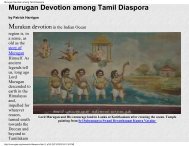
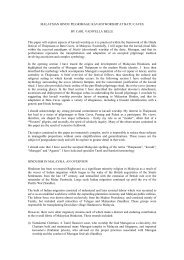
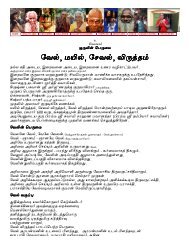
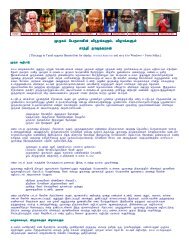
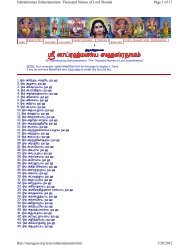
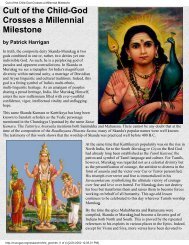
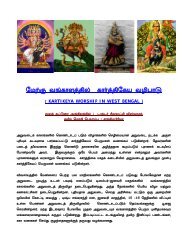
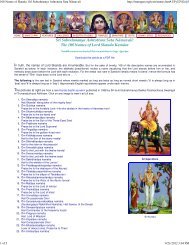
![gHdp k]y Myaj;jpw;F ghj ahj;jpiu fpuhkpa gHf;f Kiwfs;](https://img.yumpu.com/10245948/1/184x260/ghdp-ky-myajjpwf-ghj-ahjjpiu-fpuhkpa-ghff-kiwfs.jpg?quality=85)

